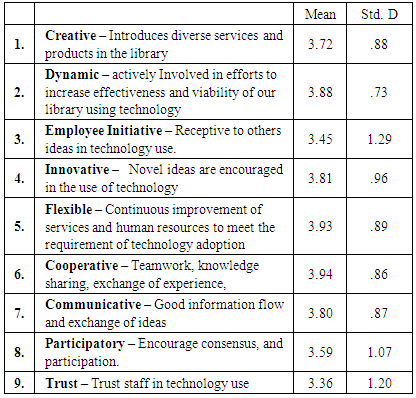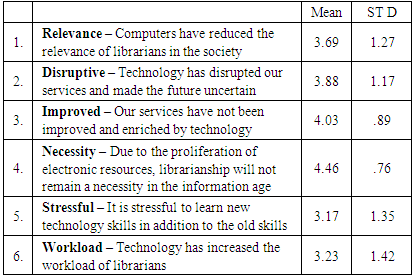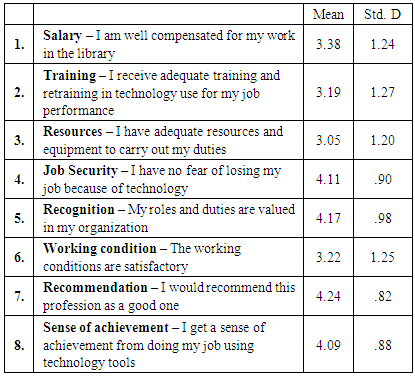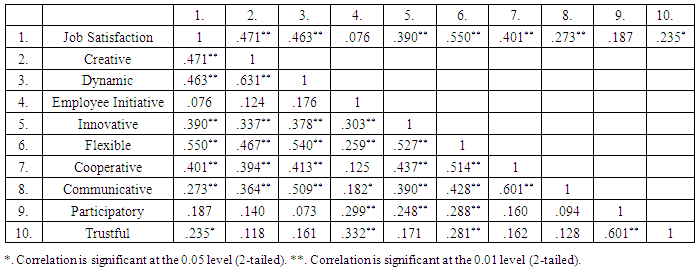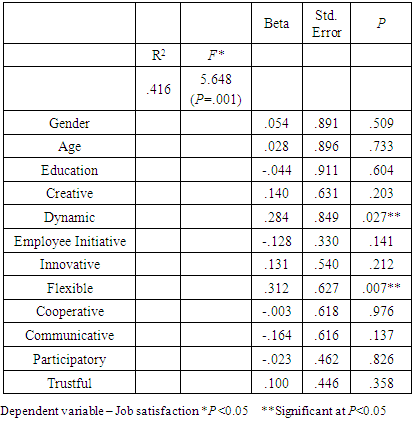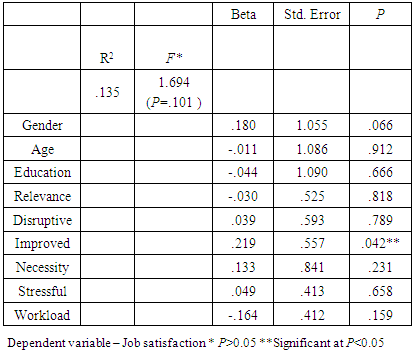-
Paper Information
- Paper Submission
-
Journal Information
- About This Journal
- Editorial Board
- Current Issue
- Archive
- Author Guidelines
- Contact Us
International Journal of Library Science
p-ISSN: 2168-488X e-ISSN: 2168-4901
2015; 4(4): 73-80
doi:10.5923/j.library.20150404.02

Technology and Job Satisfaction in Academic Libraries: Role of Leadership Style and Librarians’ Attitude
Ebele N. Anyaoku1, Nkem E. Osuigwe2, Chikelunma N. Oguaka1
1Medical Library, College of Health Sciences, Nnamdi Azikiwe University, Nnewi, Nigeria
2E-Library Awka, Nigeria
Correspondence to: Ebele N. Anyaoku, Medical Library, College of Health Sciences, Nnamdi Azikiwe University, Nnewi, Nigeria.
| Email: |  |
Copyright © 2015 Scientific & Academic Publishing. All Rights Reserved.
This work is licensed under the Creative Commons Attribution International License (CC BY).
http://creativecommons.org/licenses/by/4.0/

This study determined the role of leadership style and librarians’ attitude in job satisfaction of academic librarians in the technology driven work environment. Variables studied are leadership style, attitude to technology and job satisfaction. Questionnaire was used to collect data for the study. Questionnaires were distributed in four conference arenas hosted by Nigerian Library Association (NLA) and its sub – sections. 124 usable copies from academic librarians were obtained and analyzed to obtain results for the study. Findings suggest that there is significant positive relationship (p<0.05) between leadership styles that are creative, dynamic and flexible in technology appropriation and librarians’ job satisfaction. There was also significant positive relationship (p<0.05) between job satisfaction and librarians with positive attitude that the profession will remain a necessity in the information age and librarians that reported that technology has improved and enriched their services. Multiple regressions calculated suggest that librarians’ gender, age and education are not significantly associated with job satisfaction in technology environment when all variables are held constant. The study recommends that library leaders should increase employees’ job satisfaction through adopting technology appropriating styles that are innovative, flexible and dynamic. This will also help librarians in achieving their mission of providing information to meet the needs of the new age users.
Keywords: Job satisfaction, Leadership style, Organizational technology culture, Information and communication technologies, Technostress, Academic libraries, Job attitude
Cite this paper: Ebele N. Anyaoku, Nkem E. Osuigwe, Chikelunma N. Oguaka, Technology and Job Satisfaction in Academic Libraries: Role of Leadership Style and Librarians’ Attitude, International Journal of Library Science, Vol. 4 No. 4, 2015, pp. 73-80. doi: 10.5923/j.library.20150404.02.
Article Outline
1. Introduction
- There is a great diffusion of computers and associated technologies in the day to day activities of academic libraries. These technologies have dramatically expanded, and enhanced basic in-house duties and library routines such as acquisition, cataloguing, user’s services and other information services. Lukanic [1] noted that academic libraries are becoming not just repositories of information resources but also interactive learning and knowledge creation hubs as they perform many of their functions using software packages, catalogues that can be accessed online and links to resources in their own collections and to those outside of their physical walls. Technologies in the workplace can generate stress because of their complexities, technical complications and the necessity for multitasking and additional learning in order to use them [2]. The stress is also multiplied as some of these technologies have gone mobile enabling real-time sharing of information with work colleagues anytime, anywhere thus blurring the line between the private and professional lives of workers including librarians as they feel obliged to respond to work-related issues even at home [3] Stress arising from the use of technology has been termed technostress. Brod [4] defined technostress as a modern disease of adaptation caused by inability to cope with the new computer technologies in a healthy manner. It manifests itself in two distinct but related ways: in the struggle to accept computer technology, and in the more specialized form of over-identification with computer technology. Stress in the work place can affect job performance, quality of work life and job satisfaction of individual. Hernon and Schwartz [5] defined satisfaction as an emotional reaction—the degree of contentment or discontentment—with a specific transaction or service encounter. Job satisfaction is a pleasurable or positive feeling arising from due assessment of one’s job – the duties performed, the work environment, wages, communication systems and other \ experiences in the workplace. It is assumed that job satisfaction enhances job performance as the satisfied worker displays high levels of organizational commitment and productivity [6]. As service organisations, the issue of job satisfaction has great significance for libraries as there are always direct personal interactions between the users and librarians. Where a librarian is dissatisfied with his job, his attitude to work would be negatively displayed as he serves the clientele of the library and this would not augur well for the institution [7]. Some researchers have studied the impact of technology on job satisfaction of librarians with varied results. While some studies show positive association [8, 9], others found negative association [10]. There are many contextual factors that may determine job satisfaction of employees in the technology environment whether negative or positive. These factors need to be isolated in other to determine their exact relationship in contributing to employees’ comfort and satisfaction. These factors may stem from individual variables or organizational factors. Individual factors may include personnel’s acceptance or attitude to the use of technology based working tools. The attitude can be positive or negative depending on individuals’ perceptions of its effects on job roles and life aspirations. According to Spacey et al. [11], attitudes – chiefly positive attitudes – are assumed to be fundamental in the acceptance, implementation and success of new technologies.Organizational factors that determine job satisfaction of librarians in the technology driven library may stem from technology culture adopted by the libraries’ leaders. This is defined in terms of how leaders appropriate technology to achieve organizational aims. This include the capacity and propensity of the organization to invest wisely in research, to evaluate and select from a group of new technologies, as well as to provide for adequate employee training and proper equipment maintenance [12]. Leaders may encourage participatory involvement, trust and employee initiatives. According to Ahmad et al, [13]) IT implementation is not just a technical enhancement but a managerial decision that involves re-engineering of organizational functions and operations. The main constituent of leadership is the ability of the leaders to influence followers to achieve stated goals and objectives through interactions and processes [14]. With the great need to reduce stress associated with technology in the work place, how does organizational leadership style in technology appropriation relate to job satisfaction of librarians? Also how does attitude to technology relate to job satisfaction of academic librarians? This study aimed to find out the exact relationship between these two construct and job satisfaction of librarians in technology environment.Objectives1. To examine the relationship between organizational leadership style in technology appropriation and job satisfaction for librarians working in academic libraries2. To examine the relationship between attitude to technology and job satisfaction for librarians working in academic librariesHypothesisH1: Leadership style in technology appropriation is positively related to job satisfaction of librariansH2: Attitude to technology is positively related to job satisfaction of librariansH3: Librarians’ personal characteristics are significantly associated with leadership style in technology appropriation and job satisfactionH4: Librarians’ personal characteristics are significantly associated with attitude to technology and job satisfaction
2. Literature Review
- Technologies for information creation, storage, organisation, dissemination and retrieval are evolving at a rapid pace. Libraries as foremost information resource centres in tertiary institutions have embraced these new technologies to improve information services for research activities and for curriculum support without the constraints of space and time. This has greatly impacted the nature of library work in the past thirty years as library routines, role definitions of librarians, expected competencies, services rendered, users’ expectations and interactions with users and vendors have all changed dramatically [15]. Response to technology incursion in libraries can be gauged from attitude of librarians who work with these tools. People’s response to technology varies. While some welcome the transformations and adjust to the introduction and usage of the new technologies in the provision of information services others exhibit a feeling of inability to cope with learning and re-learning as new operating systems and computer software programmes are deployed in the library. Also, some feel threatened that the new ‘machines’ will take over their jobs and render them redundant or that other librarians who are more knowledgeable in the manipulation and usage of the new technologies will take over their jobs. These attitudes generate stress in the libraries and may affect librarians’ optimal provision of information services [16]. All these could impact on how satisfied librarians in academic libraries are with their jobs. Job satisfaction is the evaluation of how one perceives several indices of his/her job including the work environment, emoluments, communication style, job security, co-workers, supervision and professionalism amongst others [17]. Sherrer [18] sees job satisfaction as a dynamic changing idea that reflects an individual’s attitudes and expectations toward his work and goals in life. According to Qaisar, Rehman and Suffyan [19], when a worker has job satisfaction his performance will be enhanced and vice versa. Some determinants of job satisfaction are listed to include nature of work, financial rewards, opportunities for advancement, workload, supervision, and relationship with co-workers [20]. As interactive service providers, the issue of job satisfaction is of great significance for librarians in the technology era because satisfaction with technology adoption determines to a great extent librarian’s adaptability and performance. Lashbrook [21] argues that the leadership style practised in a particular workplace could influence the level of job satisfaction of its employees. Studies discovered that different leadership styles create different work environments that ultimately affect job satisfaction of employees [22, 23, 24]. Leadership styles whereby leaders are reasonably flexible in their requirement for different combinations of skills, attitudes and knowledge, with their professional and personal experiences providing strategic direction for junior colleagues, stimulate innovations and creativity could also be a mediating factor in employees’ job satisfaction. Transformational leadership style incorporates idealised influence whereby leaders through their display of skills, knowledge and ‘can do attitude’ motivate and inspire the employees to go beyond perceived attitudes, expected performance and self-interest to achieve organizational goals [25, 26]. Transformational leaders also stimulate creativity as they nudge employees to question assumptions and learn new ways of performing routine duties [27]. This leadership style will then breed an organizational culture which may play a mediating role in the interaction between technology and human resources.
3. Methods
- This is a Correlation research. The correlation research design allows testing the strength of relationships between several independent variables and dependent variable. The present research examined the relationship that exists between technology in the work place and job satisfaction. Job satisfaction was used as dependent variable, while leadership style in technology appropriation and attitude to technology were the independent variables. Questionnaire was used to collect data. The questionnaire has three sections; demographic data, organizational leadership style in technology appropriation scale (α = .880), attitude to technology use scale (α = .880) and job satisfaction scale (α = .880). They scales were on a five point Likert-type metric. Questionnaires were distributed in four national conference arenas hosted by Nigerian Library Association (NLA) and its sub sections from June 2013 to April 2014. They include NLA national conference, held in Calabar Cross River State, the Library and Information Technology Today (LITT) national workshop held in Rivers State and LRCN National workshop on Free and open Source Software in Nsukka Anambra State and The AWLIN National Conference held in Awka in April 2014. 200 Copies of the questionnaires were distributed, 124 usable copies from academic librarians were obtained.Method of data analysisFor descriptive statistics, mean scores were calculated for leadership style in technology appropriation, attitude to technology, and job satisfaction scale. Since the scales are based on a five point metrics, items with a mean score of 3.50 and above are regarded as positive and items with a mean score of below 3.50 were regarded as negative. Pearson Product Moment Correlation coefficient (r) was calculated to test the relationships between leadership style in technology appropriation, attitude to technology, and job satisfaction, Regression analysis was conducted to determine the association between demographic variables (recoded 0, 1) leadership style, attitude to technology and job satisfaction.
4. Results
- Respondent’s demographyTable 1 shows analysis of respondents’ demography. Almost two-third 63.7% (79) are females. More than half were aged 30-44 (58.9%). Majority 62 (58.1%) have masters degree and majority 34.7% (43) have worked for 11- 20 years.
|
|
|
|
5. Correlations
- Correlation between organizational leadership style in technology appropriation and job satisfactionA Pearson product-moment correlation was run to determine the relationship between leadership style in technology appropriation and job satisfaction of librarians. Result is shown in Table 5.As is shown in Table 5, there was significant positive correlation (p<0.05) between job satisfaction with almost all aspects of leadership style in technology appropriation listed in the table except employee initiative and participatory. Respondents who rated their libraries positive on creative, dynamic, cooperative, communicative, trustful and flexible in use of technology also rated their job satisfaction high. Hence H1 is accepted. There is significant positive relationship between leadership style in technology appropriation and job satisfaction of librarians.
|
|
6. Regression
- Multiple regression analysis was conducted to examine whether leadership style in technology appropriation and librarians’ personal characteristics impact on Job satisfaction of librarians in the technology environment. Table 7 shows the coefficients and their significance levels. Using the enter method it was found that the overall model fit explain 41% of the variation on job satisfaction which was revealed to be statistically significant, F(12,107) = 5.648, p<0.05. An inspection of independent variables show that librarians’ gender (Beta .054, p>0.05), age (Beta =.028, p>0.05) and education (Beta = -.044, p>0.05), were not significantly associated with job satisfaction when all the variables were held constant. However, leadership style that is dynamic (Beta =-.284, p<0.05) and flexible (Beta =-.321, p<0.05) were positively associated with job satisfaction when other variables were held constant. This suggests that leadership style that is dynamic and flexible will be positively associated with job satisfaction irrespective of age, gender and education of librarians. Based on the negative associations of demographic variables, H3 is rejected. Librarians’ personal characteristics are not significantly associated with leadership style in technology appropriation and job satisfaction.
|
|
7. Discussion
- Technology has transformed as well as changed the work environment of the 21st century academic librarian. The effect of change can be positive or negative. People’s response is determined by their perceptions of how much the changes have affected their life purposes. Findings show that library leaders were characterized positively by the respondents in technology appropriating culture which was explained as how leaders appropriate technology to achieve organizational aims. Respondents characterized their leaders as being positively (> 3.50) creative, dynamic, innovative, flexible, cooperative, communicative, and participatory. However, the organizations were characterized negatively (< 3.50) in terms of employee initiative and trust. On attitude to technology in library services, respondents were generally positive (> 3.50) on technology intermingles with the profession in the current age. High mean scores show that librarians reported that services in their libraries have been improved and enriched by technology and that librarianship will remain a necessity in the information age. Mean scores also indicated that librarians felt that technology has not disrupted services in the library and that computers have not reduced the relevance of the profession. However, in this study, librarians rated attitude to technology low (< 3.50) on two items Stressful - it is stressful to learn new technology skills in addition to the old skills and Workload - technology has increased the workload of librarians. For job satisfaction in the digital age, respondents scored job satisfaction high (> 3.50) on four items: Recommendation, Recognition, Job Security, and Sense of achievement. They rated their job satisfaction low (< 3.50) on training, salary, resources and working condition. This might mean that there need to be an improvement in the working conditions and training programmes for librarians to enable them adapt comfortably to technology use.Relationship between technology and job satisfactionA Pearson product-moment correlation was run to determine the relationship between leadership style in technology appropriation and job satisfaction. There was a significant positive correlation between job satisfaction and leadership styles that are creative, dynamic, and flexible in use of technology. There was also a significant positive correlation between job satisfaction and libraries that are innovative, cooperative, and communicative in technology use. Findings on job satisfaction and librarians’ attitude to technology adoption for job performance show that job satisfaction is positively and significantly correlated with only two variables of attitude to technology. Findings implied that respondents who reported that librarianship will remain a necessity in the information age also reported high job satisfaction. Respondents who reported that services in their libraries have been improved and enriched by technology also reported high job satisfaction. This shows that technology for this study is not highly associated with stress.Regression analysis conducted showed that librarians’ personal characteristics were not significantly associated with leadership style in technology appropriation, and job satisfaction and also that librarians personal characteristics were not significantly associated with attitude to technology and job satisfaction. This implies that gender, age and education did not predict job satisfaction for academic librarians when leadership style and attitude to technology are held constant. Librarians possibly will have equal levels of job satisfaction in an appropriate technology environment irrespective of age, gender and education. The significant positive relationships found in this study show that good leadership and positive attitude may reduce the stress associated with technology in the work place.
8. Conclusions
- Technology can be a source of stress for librarians in the performance of their duties which might lead to low job satisfaction. It is imperative to identify the factors that may help improve job satisfaction. Findings of the study show that job satisfaction is positively and significantly related to many variables of leadership style in technology appropriation. It is also significantly and positively related to two variables of attitude of librarians towards technology in the areas of libraries’ ability to harness technology and the assertion that libraries will remain a necessity in the information age. However, this study is limited by its small sample size which might not be very representative of all academic librarians in Nigeria. Nonetheless, the result is significant because due to the centrality of data collection in venues of national conferences, respondents are inclusive being drawn from academic libraries of both public and private universities in almost all states in Nigeria. This level of inclusiveness or representation reinforces the findings. It is therefore quite imperative that leaders in academic libraries have enabling technology appropriating culture which will contribute to increasing job satisfaction of library workers for greater job performance.
9. Recommendations
- Based on the findings of the study, the following recommendations will improve job satisfaction of academic librarians in the technology environment.1. Library leaders should adopt technology appropriating styles that are innovative, flexible and dynamic. This will improve job satisfaction of library professionals, and also help them in achieving their mission of providing information to meet the needs of the new age users. 2. Library leaders’ should employ good management skills that are all inclusive of harnessing technology and recognizing the needs of employees that work with the tools. In relating with subordinates, there should be good communication flow, equal participation and reward for good initiatives and ideas. This can improve employee job satisfaction and serve to motivate them for good job performance.3. Library leaders should improve their leadership skills through attendance to conferences and training workshops on organizational management especially those hosted by library organizations.4. Librarians should acquire all necessary skills needed to harness technology tools for library services. This will make them less burdensome to work with and thereby improve their attitude to their use.
 Abstract
Abstract Reference
Reference Full-Text PDF
Full-Text PDF Full-text HTML
Full-text HTML
